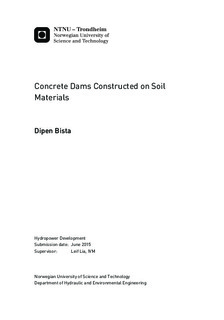Concrete Dams Constructed on Soil Materials
Master thesis
Permanent lenke
http://hdl.handle.net/11250/2350581Utgivelsesdato
2015Metadata
Vis full innførselSamlinger
Sammendrag
Rock may not always be encountered at economical depth to have foundation dam on it. It is a typical situation in Nepal where several meters deep alluvium is expected before reaching competent rock. Several dams have been constructed on soil materials and several other are in planning or construction. Uncertainties in foundation behavior of soil due to heterogeneous properties makes soil foundation unique. This study attempts to find the methods of estimating foundation response and applying it to Upper Tamakoshi hydroelectric project in Nepal.A 2D model of dam was prepared in PLAXIS 2D. The model was built in a sequence similar to construction of dam at site to get reasonable response in FEM. Due to insufficient field studies all parameters required as input parameters in PLAXIS cannot be obtained. Hence, average values of soil parameters from literature were taken for soil of similar grain size distribution. Model was run for different loading (water level) scenarios at different sections of dam. In addition, liquefaction susceptibility study was carried out and possible consequences of liquefaction was studied.Safety of dam against sliding and overturning were studied. In addition, settlement and differential settlement were studied and stress induced in dam body and on foundation soil due to differential settlement were evaluated at different stages of construction and operation. Furthermore, seepage analysis was carried out for different water level scenarios. Seepage analysis with different design of grout curtain was done and the results were evaluated and compared with current design. Bearing capacity in the soil was checked and stresses development in the dam body and foundation were checked with allowable stresses. As no penetration test were done, liquefaction susceptibility and their effects were presented in curves for different penetration resistance.In conclusion, this study has been successful in identifying key issues related to concrete dams constructed on soil materials and estimating their magnitudes and effects. Foundation studies and input parameters play key role in estimation of response close to insitu situation. Improvements on this study can be made by applying this case to a monitored dam, and comparing the results of these analysis with monitored data.
